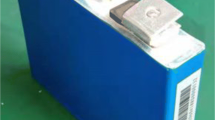Abstract
The fire problem of new energy vehicles caused by the thermal runaway of lithium-ion batteries has been the pain point of the development of the industry. Thermal runaway has become a bottleneck problem restricting the development of new energy vehicles. In this paper, a thermoelectric coupling abuse model of NCM lithium-ion battery is established, taking into account the internal heat generation and external heat transfer. Using temperature as a coupling factor, a thermal runaway model of thermal abuse of lithium-ion batteries is established. The effects of different parameters on the thermal characteristics of lithium-ion batteries are analyzed, and the thermal runaway characteristics and development rules of lithium-ion batteries under different abuse conditions are revealed.
Access this chapter
Tax calculation will be finalised at checkout
Purchases are for personal use only
Similar content being viewed by others
References
Xin, C., Yusheng, Y.: The safety of power batteries should not be underestimated. Low Carbon World 10, 36–39 (2012)
Jiahong, Z., Hongbin, P., Jiansheng, G.: Research on thermal control technology of NiMH battery for hybrid electric vehicle. Battery Indus. 6(10), 332–335 (2005)
Xuning, F.: Induction and Expansion Mechanism, Modeling and Prevention of Thermal Runaway of Automotive Lithium-Ion Power Battery. Tsinghua University, Beijing (2016)
Wen, J., Yu, Y., Chen, C.: A review on lithium-ion batteries safety issues: existing problems and possible solutions. Mater. Express 2(3), 197–212 (2012)
Macneil, D.D., Larcher, D., Dahn, J.R.: Comparison of the reactivity of various carbon electrode materials with electrolyte at elevated temperature. J. Electrochem. Soc. 146(10), 3596–3602 (1999)
Wang, D., Li, C., Ma, C., et al.: Cycle performance of a Li/Li-rich half-battery with N-allyl-N-methylpiperidinium bis(trifluoromethanesulfonyl) imide protected by a high-temperature solid electrolyte interface membrane. J. Power Sources 434, 226747 (2019)
Biensan, P., et al.: On safety of lithium-ion cells. J. Power Sources 81–82, 906–912 (1999)
Sloop, S.E., Pugh, J.K., Wang, S., Kerr, J.B., Kinoshita, K.: Chemical reactivity of PF5 and LiPF6 in ethylene carbonate/dimethyl carbonate solutions. Electrochem. Solid-State Lett. 4(4), A42–A44 (2001)
Botte, G.G., White, R.E., Zhang, Z.: Thermal stability of LiPF6-EC:EMC electrolytes for lithium-ion batteries. J. Power Sources 97–98, 570–575 (2011)
Kawamura, T., Kimura, A., Egashira, M., Okada, S., Yamaki, J.: Thermal stability of alkyl carbonate mixed-solvent electrolytes for lithium ion cells. J. Power Sources 104(2), 260–264 (2002)
Du Pasquier, A., Disma, F., Bowmer, T., Gozdz, A.S.: Differential scanning calorimetry study of the reactivity of carbon anodes in plastic Li-ion batteries. J. Electrochem. Soc. 145(2), 472–477 (1998)
Maleki, H., Deng, G., Anani, A., Howard, J.: Thermal stability studies of Li-ion cells and components. J. Electrochem. Soc. 146(9), 3224–3229 (1999)
Doughty, D.H., Butler, P.C., Jungst, R.G., Roth, E.P.: Lithium battery thermal models. Power Sources 110, 357–363 (2002)
Richard, M.N., Dahn, J.R.: Predicting electrical and thermal abuse behaviours of practical lithium-ion cells from accelerating rate calorimeter studies on small samples in electrolyte. Power Sources 79, 135–142 (1999)
Macneil, D.D., Dahn, J.R.: Test of reaction kinetics using both differential scanning and accelerating rate calorimetries as applied to the reaction of LixCoO2 in non-aqueous electrolyte. J. Phys. Chem. A 105(18), 4430–4439 (2001)
Xu, X., Sun, X., Zhao, L., Li, R., Tang, W.: Research on thermal runaway characteristics of NCM lithium-ion battery under thermal-electrical coupling abuse. Ionics 28(12), 5449–5467 (2022). https://doi.org/10.1007/s11581-022-04730-0
Author information
Authors and Affiliations
Corresponding author
Editor information
Editors and Affiliations
Rights and permissions
Copyright information
© 2023 The Author(s), under exclusive license to Springer Nature Singapore Pte Ltd.
About this paper
Cite this paper
Sun, X., Liu, G., Hu, M., Gu, R., Xu, X. (2023). Analysis of Thermal Runaway Characteristics of NCM Lithium-Ion Battery and Research on Early Warning Control Strategy. In: Proceedings of China SAE Congress 2022: Selected Papers. SAE-China 2022. Lecture Notes in Electrical Engineering, vol 1025. Springer, Singapore. https://doi.org/10.1007/978-981-99-1365-7_54
Download citation
DOI: https://doi.org/10.1007/978-981-99-1365-7_54
Published:
Publisher Name: Springer, Singapore
Print ISBN: 978-981-99-1364-0
Online ISBN: 978-981-99-1365-7
eBook Packages: EngineeringEngineering (R0)




